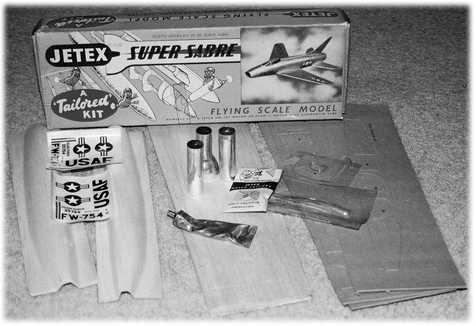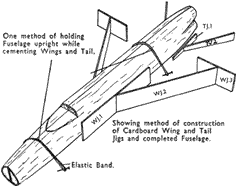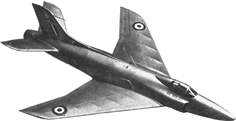|
|
|
|||
|
|
||||
|
|
||||
| The (Jet)X Files | ||||
|
|
HOME | SITE MAP | FORUM | CONTACT |
|
||
|
ABOUT | MOTORS | MODELS | ARCHIVE | HISTORY | STORE | FAQ | LINKS
|
|
|
|
|
|
|||||||||||||||||||||||||||||||||||||||||||||||||||||||||||||||||||||
|
The (Jet)X Files 1
for January 2003
by Roger Simmonds Reprinted from SAM 35 Speaks, January 2003 (with revisions) After my introduction last month, this is the first of a regular column, and a short "CV" of my modelling history would be in order. I am of the (just) post war generation, and have been making models as long as I can remember. My early efforts with "Flying Scale" rubber models and similar Jetex efforts met with, at best, only partial success. After a brief foray into control line I settled into free flight A2 and then flew R/C sailplanes happily for many years. Some time ago, however I decided that this, by now high tech world, was not for me. I now lived near Old Warden, and the "vintage scene", with its traditional values and gentle meetings, was very attractive. A current passion is to model the jets of the 1946-65 era, especially those that appeared at the SBAC Shows, and if these can be derived from old plans so much the better. I also have a great interest in CO2 replicas of old "gas" models. The Rapier motors all but dominate today's miniature jet scene, and adaptations of older designs, for example, the Vampire, MIG 15 and Avro 707, fly very well, and, (here’s a change from the old days) continuously. The motors are essentially light, ignite and launch, and a model can be back in the air (or back smoking on the ground) quickly after the last flight or crash landing. There is no waiting for the motor to cool, disassembly, or cleaning, and little misfiring. Consequently, one can use a lot of motors in a day. In cost per flight terms, they are no doubt comparable to Jetex, but a full day’s flying can appear quite expensive. With all the advantages of modern rockets, why should anyone hanker after Jetex, apart from nostalgia? Now this seems a more than adequate justification to me, but is there a rational reason for using the old motors? |
|
|||||||||||||||||||||||||||||||||||||||||||||||||||||||||||||||||||||
|
The Jetex kits in the Veron, Skyleada and Keilkraft ranges looked great in the adverts, but in the flesh, the Jetex motor "hanging in the breeze" and the non-scale trough for the exhaust were all too obvious. I realised this arrangement was practical, and learned in time not to notice, just as I was able to ignore the large cylinder head sticking out the side of a "super scale" Spitfire. Still, deep down, my youthful purism was offended, and I longed to make a "proper" jet. As far as I am aware, the Rapier motor with its blunt end and more energetic exhaust is probably not compatible with the original augmenter tubes. Wilmot Mansour appear to have believed these worked best with extended nozzles (as with the Jetmaster and the later 50 models) to maintain a smooth airflow at the intake, and a comparatively clean exhaust. I know some folk are experimenting with buried Rapiers, but modification of the tube dimensions and material is probably required. A Rapier could be buried in a Nord 'Griffon' II or Leduc 021, which had massive ramjets, but if one wishes to use a functional jet pipe in a sleek prototype, or any of the larger models, Jetex is the way to go. And yes, I know there is a lovely Hunter for ducted fan out there, but where’s the smoke? Many of the old, and to my eyes, best looking plans, featured an enclosed motor, for example the DH 108 Swallow for Jetex 200, (AM, 1952) and the Folland Midge for 50 and augmenter tube (AM, 1955). |

-
KeilKraft catalogue, c. 1961
|
|||||||||||||||||||||||||||||||||||||||||||||||||||||||||||||||||||||
Kits with a buried motor were available, including the most desirable Jetex 'Tailored' series, designed by A. A. Judge and Mike Ingram (see the advert [right]). Models included a Hunter, Swift, P.1, FD.2 and Super Sabre for Jetex 50, and a larger Swift and Hunter for the Jetmaster 150. These models had a true scale outline from all angles, and the smoke really did exit via the jet pipe. They were then, however, far beyond my purse and flying skills.  |

-
Aeromodeller, March 1955, p. 118
|
|||||||||||||||||||||||||||||||||||||||||||||||||||||||||||||||||||||
|
Unbuilt Tailored kits do turn up from time to time, but they are probably too precious to build. The illustration [above] is of a Super Sabre for the 50 size. As can be seen, kits were complete with all wood (good quality, if this example is typical) die crushed, cardboard jig, augmenter tube, motor clip, canopy, and, as was the custom in those days, a tube of glue. The unique feature of the range, justifying the name, was the moulded fuselage halves. These were, I believe, made from treated balsa sheets (about 1/32") steam moulded with a resin and cloth in the middle. Construction involved gluing these around the augmenter tube using the jig [right]. The wings, tail and fin were then glued into slots in the monocoque. This is all very neat and effective, but a drawback for today is that the models cannot be easily reconstructed from the plans. The tail and detachable wings of the larger models (about 20-21" span, 24" length) were built up, but the fixed wings of the smaller models appear to be flat sheet, which is a pity after all the trouble taken with the fuselage. The Super Sabre has a span of 7.75", a length of 10", and all up weight is quoted as 1.25 oz (about 35g). The models for the Jetex 50 appear on the small side by today’s standards and in comparison with the equivalent "Flying Scale" series. The high wing loading and flat wing can have done little for the flying characteristics. |

-
Wilmot Mansour & Co. Ltd.
|
|||||||||||||||||||||||||||||||||||||||||||||||||||||||||||||||||||||
|
Though Sebel, who took over Wilmot Mansour in 1956, carried on with these kits, even introducing some new ones like the Hunter and Crusader for Jetex 50, their semi scale Lynx for the Built up examples of these models in one piece are rare, but my friend Andy Blackwell recently found a Jetmaster Swift, made 50 years ago, complete with a loaded motor(!). Whilst the fuselage is essentially sound, the appendages have faired less well. And some wing ribs are broken or missing, and a tail spar cracked. The model had been "mended" with insulating tape. and heavily repainted in a very unscale blue and yellow. It now weighs 7 oz, which is about 3oz more than it should. Renovation is planned, and whilst it will be easy enough to restore the wings, the fuselage will have to be stripped back to the wood and carefully checked for splits and weak spots. Will Nitromoors be compatible with the moulded fuselage? We shall see. |

-
Royal Air Force Flying Review, Vol. XVI, No. 2
|
|||||||||||||||||||||||||||||||||||||||||||||||||||||||||||||||||||||
|
I would love to see the Swift and other vintage models fly again, but they cannot be flown "authentically" without a proper Jetex motor. I really hope the current Jetex fuel problems can be solved in a way that is commercially viable. Does anyone remember these models? Did they fly well? Or at all? I know that John Nesbitt had a restored Hunter flying in 1993. I would really welcome any reminiscences about these models and their flying characteristics. I am also looking for plans of the Tailored FD.2. Many small jet models can be seen can be seen at Mike Stuart's wonderful website (www.thestuarts.freeserve.co.uk). I hope my own FD.2 will be on display. Very nice it looks too, except, unfortunately, it has a visible motor and a trough. Ugh! |

-
Aeromodeller
|
|||||||||||||||||||||||||||||||||||||||||||||||||||||||||||||||||||||
|
|
|
|||||||||||||||||||||||||||||||||||||||||||||||||||||||||||||||||||||
|
|
|
|
|
|
|
|
Acknowledgements - Article and illustrations (Lynx, Jetex 'Tailored' advertisement, Super Sabre, 'Tailored' jig) contributed by Roger Simmonds - Illustration (KeilKraft catalogue) contributed by Brian Benson |
|
|
|
|
ABOUT | MOTORS | MODELS | ARCHIVE | HISTORY | STORE | FAQ | LINKS |
|
|
Terms of Use
|
Queries? Corrections? Additions?
Please
contact us.
|
|